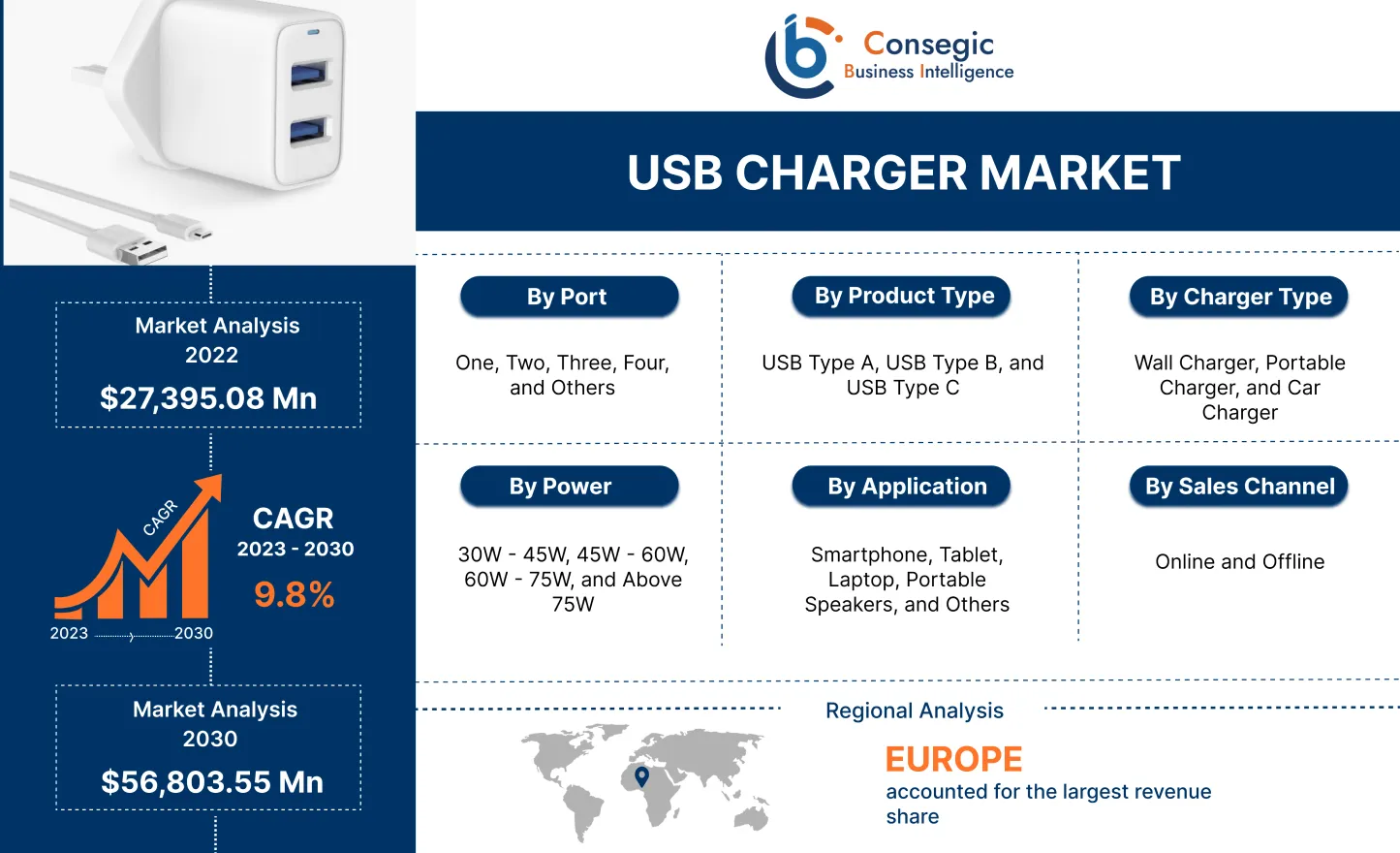USB Charger Market Size :
Global USB Charger Market Size is estimated to reach over USD 56,803.55 Million by 2030 from a value of USD 27,395.08 Million in 2022, growing at a CAGR of 9.8% from 2023 to 2030.
USB Charger Market Scope & Overview:
A USB charger is a compact and portable device that provides power to charge electronic devices through a USB (Universal Serial Bus) connection. They are widely used for charging smartphones, tablets, digital cameras, portable speakers, wearable devices, and other electronic gadgets. USB chargers are available in various formats, including wall chargers, car chargers, and power banks, catering to diverse user needs. Equipped with advanced circuitry and built-in safeguards, USB chargers protect against overcharging, overheating, and short circuits, ensuring safe and efficient charging. Modern USB chargers often feature multiple ports to charge several devices simultaneously and may support advanced charging technologies like Quick Charge, Power Delivery (PD), or adaptive charging for faster and optimized power delivery. Some chargers are also integrated with smart chips to automatically adjust power output based on the device's requirements, enhancing energy efficiency and device longevity.
USB Charger Market Insights :
USB Charger Market Dynamics - (DRO) :
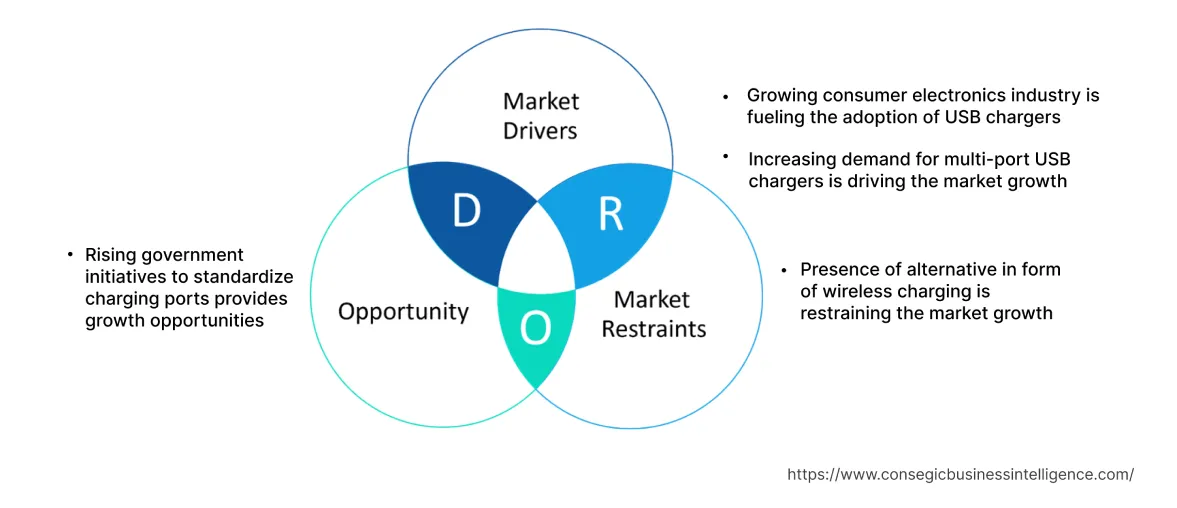
Key Drivers :
Growing consumer electronics industry drives the market.
The USB chargers provide a convenient charging solution, enabling users to charge electronic devices using a single cable and USB power adapter, thus eliminating the need for multiple chargers for different devices. Additionally, they are portable and are hence widely used to charge various consumer electronic devices including smartphones, tablets, laptops, and others. Their ability to fast charge the devices is considered to be one of the key factors driving the usage of chargers to power consumer electronics. Also, factors including technological advancement and increasing requirements for connected devices are resulting in the increasing need for them. Analysis of market trends concludes that the surging penetration of smartphones, laptops, and other consumer devices with the incorporation of advanced features is the primary factor driving the expansion of the consumer electronics sector, in turn positively impacting the adoption of chargers. According to recent insights from Atradius, the consumer electronics sector in Spain grew by 3.5% in 2021 in comparison to 2020. Meanwhile, recent insights from Oxford Economics state that the total output of the overall electronics sector in South Korea witnessed a YoY growth of around 21.8% in 2021 and it is estimated to witness a growth of 10.8% by the end of 2022. Therefore, attributing to the factors mentioned above, the growing consumer electronics industry is boosting the USB charger market demand globally.
Increasing demand for multi-port USB chargers propels the market.
The demand for multi-port USB chargers is increasing significantly due to their ability to charge multiple devices simultaneously, offering convenience and efficiency for users. These chargers are designed with intelligent power distribution systems to ensure each connected device receives the optimal amount of power, enhancing performance and safety. The rising trends in travel and mobility are further propelling the adoption of multi-port chargers, as they allow users to charge multiple gadgets without needing multiple outlets.
For example, the Universal Travel Adapter by Cadyce includes fast-charging USB ports, catering to frequent travelers. Additionally, features like increased charging efficiency, compact designs, and the ability to enhance user productivity are major factors driving the adoption of these chargers. As a result, multi-port USB chargers are contributing significantly to the growth of the USB charger market, addressing both individual and professional needs.
Key Restraints:
Presence of alternative in the form of wireless charging limits the market.
The presence of wireless charging as an alternative to traditional USB chargers poses a significant challenge to the USB charger market. Wireless charging offers several advantages, including eliminating the need for cables and connectors, which enhances convenience and ease of use. This cable-free approach reduces clutter and minimizes the wear and tear on connectors and device ports caused by frequent plugging and unplugging, a key factor driving the adoption of wireless chargers.
Additionally, wireless chargers provide greater flexibility in device placement, allowing users to charge devices without precise alignment or connection to ports. These benefits align with consumer preferences for seamless and hassle-free charging solutions. Market trends indicate that the growing adoption of wireless chargers, particularly with advancements in technology like fast wireless charging and integration into furniture and vehicles, is gradually restraining the growth of the USB charger market globally, as users shift towards this alternative.
Future Opportunities:
Rising government initiatives to standardize charging ports creates new opportunities.
Rising government initiatives to standardize charging ports are significantly influencing the USB charger market by promoting universal charging solutions for electronic devices. USB chargers provide a standardized charging interface that is compatible with a wide range of devices, including smartphones, tablets, smartwatches, and portable speakers, simplifying charging needs for consumers. Several governments are implementing regulations to standardize charging ports, ensuring universal compatibility and reducing electronic waste.
For instance, in October 2022, the European Parliament mandated that all mobile phones, cameras, and tablets sold in the EU must be equipped with USB Type-C charging ports by 2024. This move aims to streamline charging interfaces and enhance convenience for users while addressing environmental concerns. Such initiatives are creating opportunities for market growth, as the adoption of standardized ports drives demand for USB chargers that align with these regulations. These developments are expected to play a pivotal role in the expansion of the USB charger market during the forecast period.
USB Charger Market Report Insights :
| Report Attributes | Report Details |
| Study Timeline | 2017-2030 |
| Market Size in 2030 | USD 56,803.55 Million |
| CAGR (2023-2030) | 9.8% |
| By Product Type | USB Type A, USB Type B, and USB Type C |
| By Charger Type | Wall Charger, Portable Charger, and Car Charger |
| By Port | One, Two, Three, Four, and Others |
| By Power | 30W - 45W, 45W - 60W, 60W - 75W, and Above 75W |
| By Application | Smartphone, Tablet, Laptop, Portable Speakers, and Others |
| By Sales Channel | Online and Offline |
| By Region | North America, Europe, Asia-Pacific, Latin America, and Middle East & Africa |
| Key Players | Just Wireless, Huntkey, Petra Industries, LLC, Baccus Global LLC, Xiaomi, Verizon, Eaton, Inter IKEA Systems BV, NCC Corp, SDI Technologies, AT&T Inc, DB Power Limited |
USB Charger Market Segmental Analysis :
By Product Type :
Based on the type, the market is segregated into USB Type A, USB Type B, and USB Type C. The USB Type The USB Type A segment dominated the market with a substantial revenue share of 46.21% in 2022. USB Type A chargers are one of the most common and widely used types of chargers, primarily due to their affordability, ease of use, and universal compatibility. These chargers are characterized by a rectangular connector with a flat, elongated shape, designed to be inserted in only one orientation, ensuring a reliable connection. They are commonly used for charging small devices like portable speakers, wireless headphones, wireless mice, keyboards, and other consumer electronics. One of the key advantages of USB Type A chargers is their cost-effectiveness, making them a preferred option for manufacturers looking to offer budget-friendly charging solutions. Despite newer technologies emerging, USB Type A remains widely used, particularly in legacy devices, due to its established standard and the widespread availability of compatible ports and cables.
The USB Type C segment is expected to register the fastest CAGR during the forecast period, driven by the rapid adoption of newer technologies in electronic devices. USB Type C chargers are characterized by their symmetrical design, which allows the connector to be inserted in either orientation, making them more user-friendly and reducing wear on the connectors. They also feature high-speed data transfer and fast-charging capabilities, which are increasingly important in a market that demands efficient power delivery. USB Type C supports higher power output, typically up to 100W, enabling it to charge not only smartphones and tablets but also laptops, gaming consoles, and other high-power devices. This versatility has made USB Type C the preferred standard for modern smartphones, laptops, and other portable electronics. Additionally, the introduction of USB Power Delivery (PD) technology further enhances its appeal by allowing adaptive charging, which adjusts power output depending on the device’s needs. This ensures optimal charging speeds, improves energy efficiency, and extends the lifespan of devices. With major companies, including Apple, Samsung, and Google, pushing for USB Type C integration, the segment is poised for significant growth as more electronic devices adopt this versatile standard.
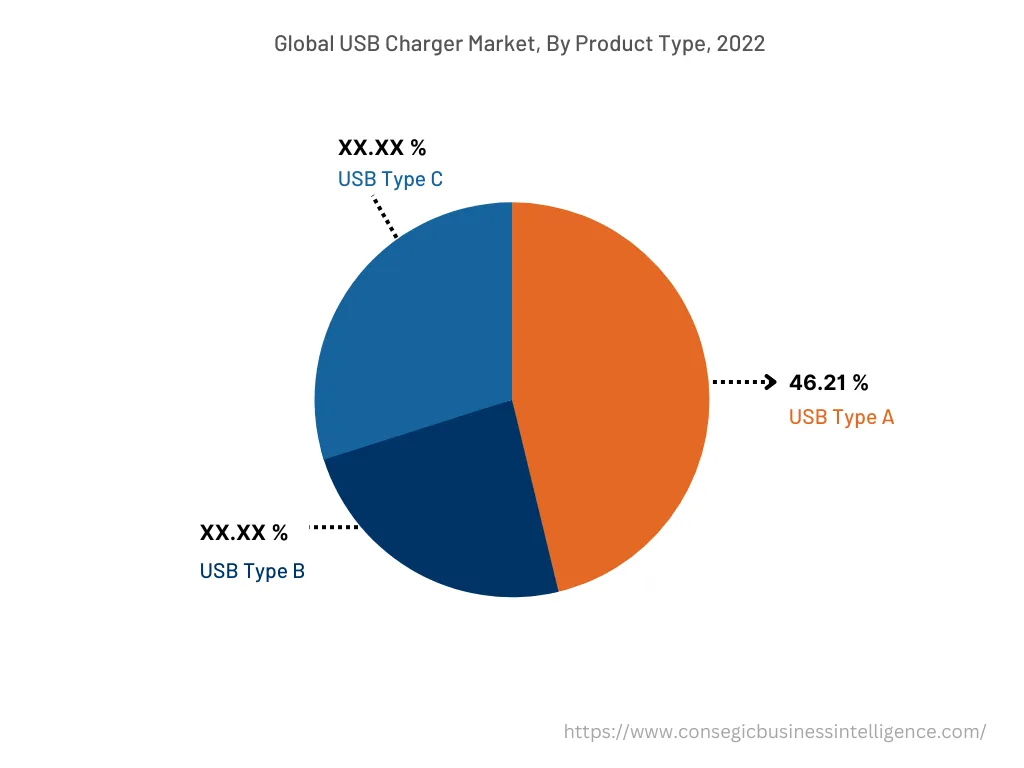
By Charger Type :
Based on the charger type, the market is classified as Wall Charger, Portable Charger, and Car Charger. In 2022, the Wall Charger segment held the largest market share in the USB charger industry. Wall chargers, also known as USB wall adapters, are designed to plug into a standard wall outlet and provide power to electronic devices. They are essential for charging a wide range of USB-powered devices, such as smartphones, smartwatches, tablets, and other small electronics. The increasing number of USB-powered devices in the market is a significant driver of the wall charger demand. With the rise of connected and portable technology, consumers need reliable and accessible charging solutions, which the wall charger provides. Factors such as convenience, easy accessibility, and cost-effectiveness make wall chargers a go-to choice for consumers. The widespread adoption of USB Type-C chargers for faster and more efficient charging is also contributing to the popularity of wall chargers, particularly for devices like smartphones, laptops, and gaming consoles.
The Portable Charger segment is expected to witness the fastest CAGR during the forecast period, fueled by the growing demand for on-the-go charging solutions. Portable chargers, also known as power banks, store electrical energy to charge devices when users are away from wall outlets, making them particularly useful for travelers, commuters, and outdoor enthusiasts. The trend towards mobility and the increasing reliance on smartphones, laptops, and wearable technology for everyday tasks are key factors driving the demand for portable chargers. As consumers seek the convenience of charging their devices anytime and anywhere, portable chargers are becoming an essential accessory. Additionally, the launch of high-capacity portable chargers designed to power laptops and other high-power devices is enhancing the growth prospects of this segment. For example, in August 2022, Lenovo introduced a portable charger specifically designed for charging laptops, addressing the needs of professionals and students who require portable power solutions for extended periods. This trend toward larger and more efficient portable chargers is expected to continue driving market growth.
By Port :
Based on the ports, the market is classified into One, Two, Three, Four, and Others. The One-Port segment accounted for the largest market share in 2022. One-port USB chargers are the most basic and widely used type of charger, offering a single USB port to charge one device at a time. These chargers are generally more affordable than multi-port chargers, which contributes significantly to their popularity, especially among consumers seeking low-cost and simple charging solutions. Additionally, the trend toward compact and lightweight chargers is fueling the demand for one-port chargers, as they are easy to carry and convenient for users who only need to charge one device at a time. The widespread use of smartphones, wearables, and small electronics that require basic charging makes one-port chargers a ubiquitous solution for everyday charging needs. These devices are often favored for their portability and cost-efficiency, making them a preferred choice for individual users and households.
The Four-Port segment is projected to experience the fastest CAGR during the forecast period. Four-port chargers are designed to charge up to four electronic devices simultaneously, offering significant convenience for users with multiple devices. These chargers are especially useful in households, offices, and traveling scenarios where several devices need to be charged at once, such as smartphones, tablets, wireless headphones, and power banks. For example, RAVPOWER manufactures a 40W 8A 4-Port Desktop Charger that allows users to charge smartphones, headphones, power banks, and other small devices at the same time, enhancing efficiency and reducing the need for multiple charging outlets. The rising adoption of multi-device charging solutions, coupled with the broad compatibility of four-port chargers, is expected to drive their market growth. Additionally, the ability to charge various devices at once reduces clutter and makes these chargers highly appealing for tech-savvy consumers, families, and professionals who need to keep multiple devices powered simultaneously.
By Power :
Based on the power, the market is categorized as 30W - 45W, 45W - 60W, 60W - 75W, and above 75W. The 45W - 60W segment was the largest in terms of revenue share in 2022. Chargers in this power range are suitable for charging a variety of mid-to-high performance devices, such as smartphones, tablets, gaming consoles, and other electronic devices that require higher power levels for optimal performance and fast charging speeds. These chargers can efficiently deliver the required wattage to charge devices quickly without compromising safety. The growing adoption of smartphones, which often come with fast-charging capabilities, is one of the primary drivers for the increasing demand for 45W - 60W chargers. Additionally, the ability to charge smartphones, tablets, and other mobile devices at fast speeds is an attractive feature for consumers, further boosting the demand for chargers in this power range.
The Above 75W segment is expected to witness the fastest CAGR during the forecast period. Chargers in this category are specifically designed to meet the needs of high-power devices that require substantial charging capacity, such as high-end gaming laptops, professional-grade workstations, and other power-hungry electronics. These chargers are particularly useful for gaming enthusiasts and professionals who rely on laptops with powerful processors and graphics cards that require higher power input. As gaming continues to be a rapidly growing industry, with an increasing number of consumers investing in gaming laptops and consoles, the demand for chargers that can handle substantial power outputs is set to rise. Furthermore, with the surge in demand for laptop gaming and the push for portable, high-performance computing, chargers rated above 75W are becoming essential. This is further fueled by advancements in USB Type-C charging technology, which supports higher power output and faster charging times for devices that demand more power.
By Application :
Based on the application, the market is classified as Smartphone, Tablet, Laptop, Desktop, and Others. The smartphone segment accounted for the largest revenue share in 2022 and is expected to grow at the fastest CAGR during the forecast period. The increasing dependence on smartphones for communication, productivity, and entertainment is a major factor driving the demand for smartphone chargers. As smartphones continue to advance with features requiring more power, the need for efficient, reliable, and fast charging solutions has surged. The introduction of energy-efficient chargers by companies like Samsung, along with innovations in USB Type-C and Quick Charge technologies, is expected to further fuel market growth, as consumers seek optimized, sustainable charging options for their devices.
By Sales Channel :
Based on the sales channel, the market is bifurcated into online and offline. The offline sales channel segment accounted for the largest revenue share in the year 2022. The offline sales channels for the chargers comprise of several modes including supermarkets, hypermarkets, convenience stores, departmental stores, and others. The Offline stores sell the same products of different brands and, hence are preferred by consumers to differentiate between several brands before buying the products. Furthermore, several benefits including immediate sales, increased product visibility, local market reach, and others are fueling the adoption of offline sales channels by the manufacturing companies for the chargers.
The online sales channel segment is anticipated to witness the fastest CAGR growth during the forecast period. The online segment includes e-commerce channels such as Amazon, Flipkart, Alibaba, and others. This segment can be used by both residential and commercial customers for purchasing the chargers. Analysis of USB charger market trends concludes that the factors including rising internet penetration and the influence of social media are expected to boost the number of online sales channels for USD chargers during the forecast period. For instance, as per Eurostat, by 2021, the contribution of EU households with internet access had risen to 92 %, 20 percentage points higher than in 2011 (72%).
By Region :
The regional segment includes North America, Europe, Asia Pacific, the Middle East and Africa, and Latin America.
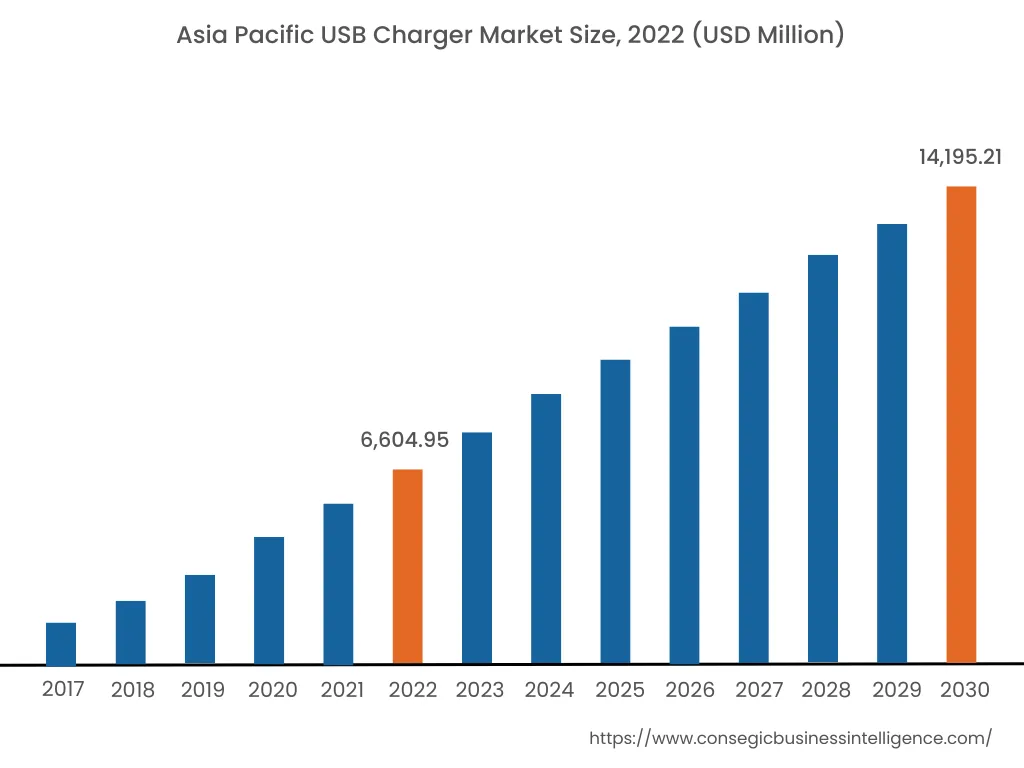
Europe accounted for the largest revenue in the year 2022 valued at USD 9,919.76 million and is projected to grow at a CAGR of 10.0% during the forecast period. The USB charger market analysis concluded that the increasing adoption of smartphones is driving the proliferation of the USB Charger market in the region. Moreover, the surge in the trend toward gaming is increasing the usage of gaming laptops in the region, in turn boosting the adoption of chargers.
The Asia-Pacific region is anticipated to witness the fastest CAGR of 10.3% during the forecast period. In addition, in the region, China accounted for the maximum revenue of 28.3% in the same year. The USB charger market analysis concluded that the growing demand for consumer electronics products including laptops, computers, and mobile phones among others is boosting the proliferation of the market in the region. For instance, according to International Data Corporation (IDC), the traditional personal computer market in India witnessed a rise of 37.7% during the first quarter of 2022. Moreover, increasing government initiatives to standardize charging ports is anticipated to positively impact the market expansion during the forecast period. For instance, in December 2022, the Bureau of Indian Standards (BIS) mandated smartphones in India to be equipped with USB Type C ports by 2025.
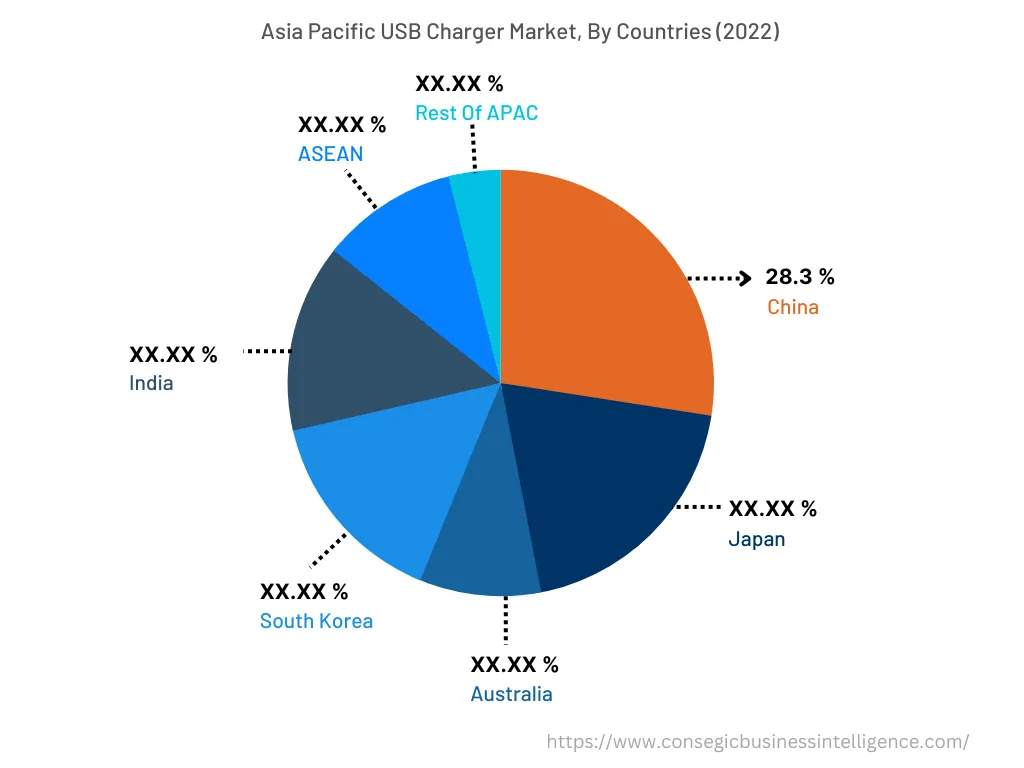
Top Key Players & Market Share Insights:
The USB Charger Market is highly competitive due to the presence of a large number of key players operating in the market. The report analyses detailed profiles of the major companies operating in the USB charger industry. Further, the surge in Research and Development (R&D), product innovation, various business strategies, and application launches have accelerated the market proliferation. Key players in the USB Charger market include-
- Just Wireless
- Huntkey
- NCC Corp
- SDI Technologies
- AT&T Inc
- DB Power Limited
- Petra Industries, LLC
- Baccus Global LLC
- Xiaomi
- Verizon
- Eaton
- Inter IKEA Systems BV
Recent Industry Developments :
- In March 2022, Anker launched 35W UCS Type C wall charger comprising of 2 ports of 20W and 15W power delivery in India. The company has launched the products to expand its presence in the Asia Pacific region.
- In January 2023, Belkin announced the launch of eco-friendly USB chargers for iPad, Mac, and iPhone.
Key Questions Answered in the Report
What is USB Charger? +
A USB charger is a device that provides power to charge electronic devices through a USB (Universal Serial Bus) connection. The USB chargers are used to charge several electronic devices including smartphones, laptops, tablets, and others.
What specific segmentation details are covered in the USB Charger Market report, and how is the dominating segment impacting the market growth? +
The report consists of segments including Product Type, Charger Type, Port, Power, Application, and Sales Channel. Each segment has key dominating sub-segment being driven by the industry trends and market dynamics. For instance, by type segment has witnessed Type A as the dominating segment in the year 2022 due to the increasing demand for reliable charging solution.
What specific segmentation details are covered in the USB Charger Market report, and how is the fastest segment anticipated to impact the market growth? +
The report consists of segments including Product Type, Charger Type, Port, Power, Application, and Sales Channel. Each segment is projected to have the fastest-growing sub-segment being fuelled by industry trends and drivers. For instance, by sales channel segment has witnessed online as the fastest-growing segment due to increasing internet penetration globally.
Which region/country is anticipated to witness the highest CAGR during the forecast period, 2023-2030? +
The Asia-Pacific region is anticipated to witness fastest CAGR growth during the forecast period due to the increasing demand for consumer electronics in the region.
